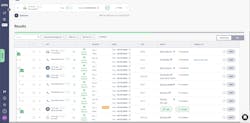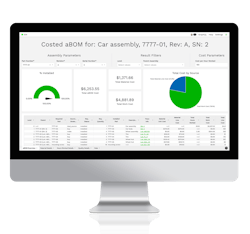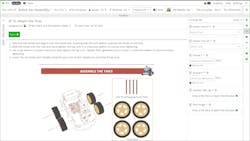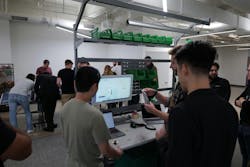Connectivity and data have made outmoded the practice of working in siloes. So much so, that we might think of manufacturing as a team sport, according to Karan Talati.
The need and demand for integrated manufacturing rings especially true where manufacturers build complex hardware, components and products that depend on multiple levels of the BOM (bill of materials) and multiple manufacturing processes, according to the CEO and co-founder of First Resonance, a Los Angeles-based startup that develops production management software for aviation, aerospace, defense, energy robotics and automotive.
First Resonance hopes to solve the issue of disconnected processes across disparate working teams with its ION platform by helping engineers and factory operators coordinate and manage the workflow along the complex supply chain.
READ MORE: Custom Motor Design: SaaS Platform Brings Flexibility to PCB Stator Design
“As we’ve seen over the past few years, supply chain disruptions have shown that missing just one part—a critical chip, for example—could lead to an entire hardware operation getting off the tracks because of that rigidity and the bill of materials that was originally defined,” explained Talati. “In an era where manufacturers need to adapt to that supply chain change and dynamism, it can be quite difficult to do all of that manually,” he said.
Moreover, the excitement around the Industrial Internet of Things (IIoT) witnessed over the past 10 years cultivated fresh opportunities and challenges. Business and operational systems were never built to receive data from a highly distributed array of sensors and equipment, Talati pointed out.
“While the promise is great of an increasing number of devices and sensors having Wi-Fi connectivity, the reality has been that getting data back into the business or operational systems is an unsolved problem,” he said. And when it comes to integrated manufacturing and Industry 4.0, “the promise has been really high, but actually stitching this data back into that business systems layer or the operational layer has been unmet.”
First Resonance couches its business proposition around solving these shortcomings. The startup’s factory operating system helps manufacturers connect their workflows, coordinate processes and get ahead by making proactive decisions on their inventory and supply chain.
ION has been developed with an API-first approach, according to Talati. API stands for Application Programming Interface, which means the software interface provides a way for two computer programs to communicate; it takes requests from one system, tells another what to do and then brings information back. In ION’s case, every transaction in the platform—that is, what’s available through the API or what’s available through various app ecosystem partners—can be connected through the API.
“As we see an increasingly programmatic workforce—people who know just a little bit of code to move bits and bytes around—we’re creating a [software] layer to make it very easy for them to get that information from those sensors or that equipment back into the same layer that operators and technicians are working on, or the same layer that people are analyzing their factories on, so they could stitch this wide array of data back into the traditional manufacturing process,” explained Talati.
Developing a scalable and flexible proposition and a vision of the factory of the future required Talati and his team to learn all they could about the supply chain from a first principles perspective: “What is the latest and greatest in technology? What are the problems that we have to solve? And at that time, what we put a lot of value on was, how do we improve and increase the velocity of our engineering to manufacturing iterations? How do we get good information from engineering down to the shop floor and then quickly get that data back up to make more rapid decisions and improve the product? We thought very deeply about that, and employed some of these tactics of modern APIs and connectivity.”
Talati spent a number of years automating projects at SpaceX before venturing on his own five years ago. In the abridged Q&A below, he shares the rationale behind the startup's integrated platform that’s designed to capture and record the entire hardware build.
Machine Design: You’re also talking about an open API, right? Tell us more about these specs. And what would be needed in a basic integration?
Karan Talati: About 15 years ago, there was a huge trend in standardization of APIs, specifically REST APIs. And since then, there’s been a few evolutions of that, including GraphQL. GraphQL is an API spec that defines the structure in which one can retrieve data from a system, as well as send data back. That’s the aspect that we have adopted into the ION API. Because it’s a standardized API, because of the power of GraphQL, the API is actually self-documenting.
READ MORE: Software is Key to Realizing the Idea of a Dark Facility
So, within the platform we’ve created an API playground that allows manufacturing programmers, engineers, etc., or people working in the manufacturing operation, to quickly test interactions with API. They use it to understand how to get data out of the system for automated decision-making or running an automated process such as a robotics process, and then sending data back. Things like numerical results or measurements. It’s all built within that API playground, so they could quickly test it and then bring that into their code.
What we’ve seen as well is that there’s been a burst of capabilities for developers, whether the developer is writing in JavaScript, Python or something more low-level at the PLC level. In the manufacturing environment they can actually interact with ION in the same standard API spec as web developers do today building the Internet.
Editor’s Note: REST stands Representational State Transfer. It is an architectural style or set of rules that developers follow for an application program interface (API) that requests access and use data. GraphQL is open-source data query and manipulation language for APIs and a query runtime engine.
MD: This brings to mind the promise of capturing institutional knowledge, which has long been a bane for manufacturers facing skills shortages or labor shortages, and capturing data or rich data for that matter. Can you share use cases that demonstrate how you’re able to collect and use historical data, or data used for certification or troubleshooting and the handover to engineers?
KT: Absolutely. I’ll give you an example. At a company called Vast Space, they’re building large-scale space applications. Think of things like space stations and various other applications there. What they use ION for is to conduct the day-to-day operations in manufacturing. That includes defining work instructions, defining the routing of how a factory is going to work, as well as the data that they need collected back from the manufacturing operation. That’s the main use case.
The amazingly exciting thing about working with a company like Vas is that they have an increasingly programmatic workforce—manufacturing engineers and mechanical engineers—who are able to write just enough code to start automating things. Now, this is really a great example of that technical side coming into play with the business side in applications like aerospace. What Vast is working on in data traceability is paramount for things like quality control and quality audits, as well as what you mentioned, Rehana: certification processes of having traceability around the entire build for something as complex as an aerospace part.
Using the combination of the platform they’re able to set up their factory processes, collect data, as well as automate that data collection to create an entire build record at the end of the hardware build to quickly diagnose their manufacturing process where necessary, but also to have the supporting documentation for regulatory purposes.
A lot of our customers that are in aerospace use ION to be the system of record to capture this data across their entire process—whether that’s manually input data from the technician or operator, or this automatically collected data, as I was describing before. At the end, you get a data package that gives you confidence on exactly how your hardware product was built to spec, and something that they can hand off to regulators, like the FAA or to the United States Space Force to certify and continue moving their product forward into the operational side.





